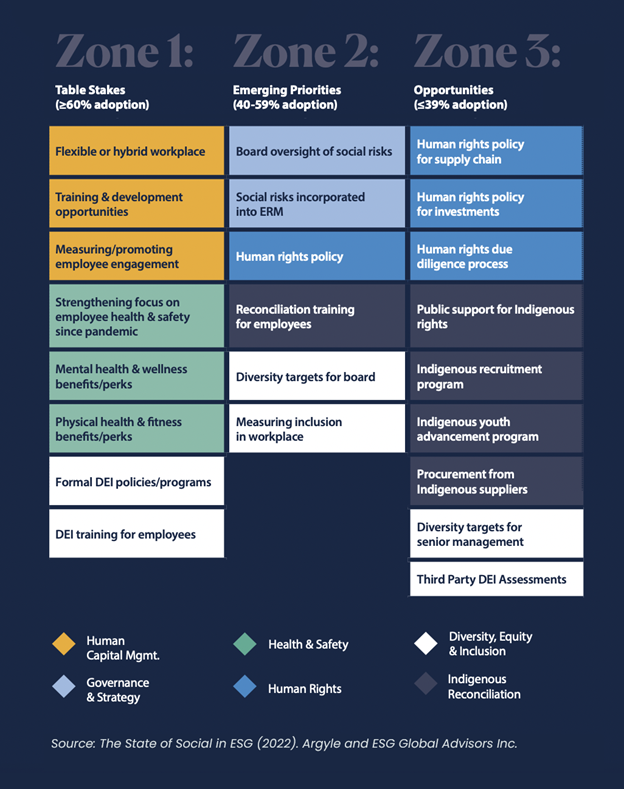
Over the past few years, climate change has been a driving force behind the rapid growth of investments that consider ESG factors. While the focus on the “E” in ESG is warranted, recent and emerging trends suggest we’re entering a new era for the “S” — an era defined by social risks that investors and companies cannot ignore.
A constellation of social risks
The pandemic and racial reckonings that began in 2020 brought social risks to the forefront as companies were compelled to focus on employees’ well-being while strengthening efforts to support diversity, equity and inclusion (DEI) and Indigenous reconciliation.
The ripple effects of these events will continue to reshape power dynamics between employers and employees as the latter demand flexible work in more inclusive, human-centric environments. Even when unemployment inevitably ticks up and the power pendulum swings back to employers, the war for talent will persist, as savvy companies will leverage flexibility, inclusion and other non-financial tools to poach top talent from those who roll back pandemic-era flexibility.
Meanwhile, inflation is at the highest levels we’ve seen in four decades, and most economists expect an economic downturn within the next year. These macroeconomic forces will squeeze personal finances, exacerbate economic inequality and reduce aggregate demand. Rising inequality could erode social cohesion and worsen political polarization at a time when social tensions are already running hot after years of pandemic restrictions and political tumult.
Tragically, Russia’s invasion of Ukraine put a spotlight on human rights concerns, raising questions about business dealings with authoritarian regimes and exposure to human rights issues in supply chains.
Looking ahead, Statistics Canada estimates that automation and artificial intelligence will put a staggering 39.7% of the country’s workforce at a moderate (29.1%) to high (10.6%) risk of displacement. The energy transition will amplify displacement as jobs move from high-carbon to low-carbon industries, leading to growing calls for a “just transition.”
In short, a constellation of palpable social risks is emerging. We don’t need to rely on scientific models to see it.
These risks will pressure companies through multiple channels, including talent management, supply chains and governance. Companies that fail to meet consumer, stakeholder and rightsholder expectations on DEI, reconciliation and human rights will be gambling with their talent and putting their social licence at risk. Some of the social risks noted above, such as mass displacement and worsening inequality, are systemic and thus point to a need for both collective and individual actions to manage exposure and drive real-world impact.
The current state of social
Are companies positioned to successfully navigate this new era for the “S” in ESG? According to new research from ESG Global Advisors and Argyle, the short answer is, well, yes and no.
Our report “The State of Social in ESG” presents survey data from 73 organizations in Canada and the U.S. covering practices related to six social themes: human capital management, employee health and safety, DEI, Indigenous reconciliation, human rights, and governance and strategy around social issues.
One of the key findings is that some social risks are better managed than others. The table below provides a snapshot of how survey respondents performed across the six research themes, organized into three zones as follows:
- Zone 1: Table stakes — practices adopted by a strong majority (≥60%) of survey participants and that represent business imperatives
- Zone 2: Emerging priorities — practices adopted by roughly half (40%–59%) of participants and that represent emerging priorities
- Zone 3: Opportunities — practices implemented by a minority (≤39%) of early adopters and that represent opportunities for growth
Table: Three zones of social performance

As shown in the table, practices we’ve categorized under human capital management and employee health and safety are the most widely adopted. Social practices related to governance and strategy are adopted by a middle range of participants, while practices related to human rights and Indigenous reconciliation are not widely adopted. DEI practices are unique in that they fall into all three zones, with foundational practices such as DEI policies and DEI training seeing wide adoption, while more outcome-focused practices such as diversity targets and third-party assessments (e.g., racial or pay equity audits) are adopted by few.
Opportunities for investors and asset managers
Here are eight ways that investors and asset managers can manage exposure to social risks in their portfolios:
- Social risk analysis: Review corporate disclosures for social practices, looking to the SASB Standards to identify material social risks. “The State of Social in ESG” report can provide a useful benchmarking tool to assess whether issuers are leading, lagging or somewhere in between.
- Human rights due diligence: Surprisingly few organizations have human rights due diligence processes covering their supply chains and investment decisions, which could expose them to human rights issues, especially in the context of growing human rights legislation in Canada and internationally. Investors should start with a human rights policy, extend it to their investments, and support it with a due diligence process informed by the UN Guiding Principles on Business and Human Rights.
- Reconciliation action plan: Look for issuers, particularly those in extractive industries, to develop a reconciliation action plan. Investment managers can also develop such plans themselves, starting with a public statement in support of Indigenous rights and a commitment to incorporate that support into investment decisions and engagements with issuers.
- Corporate engagement: Engage with portfolio companies to communicate investor expectations related to social risks and opportunities, ideally in collaboration with peer investors since research has shown that collaborative engagement can elevate impacts.
- Manager engagement: Direct engagement with companies requires substantial resources. Advisors who offer funds can engage with their fund reps to ask about their voting practices on social issues and how the fund manager is mitigating exposure to social risks and opportunities.
- Real-world impact: New data show that investors are pulling assets from “light touch” ESG funds and moving into funds with specific ESG objectives. In other words, investors want real-world impact, and this presents a big opportunity for investment managers to develop strategies focused on generating real-world outcomes.
- Policy advocacy: Issues like just transition and widening inequality are systemic and cannot be addressed by the private sector alone. Engagement with governments and regulators can help policy-makers understand where investors stand on societal risks.
- Signatory support: Institutions can sign the Canadian Investor Statement on Diversity & Inclusion to join more than 50 institutional investors managing some $4 trillion in assets as they strive towards DEI best practices in their portfolios and their own organizations.
Conclusion
While the “S” in ESG has been largely overshadowed by the “E” to date, recent and emerging trends have thrust social risks into the spotlight, and these risks will intensify over time as macro trends disrupt labour markets, exacerbate inequality, unveil human rights issues, and extend the war for talent even as unemployment eventually ticks up. Companies that adapt to meet the rising expectations of consumers, stakeholders and rightsholders will attract talent, generate business opportunities and strengthen their reputations, while those who fail to adapt may struggle to compete in the new era of “S” in ESG.
Dustyn Lanz is senior advisor with ESG Global Advisors Inc.
